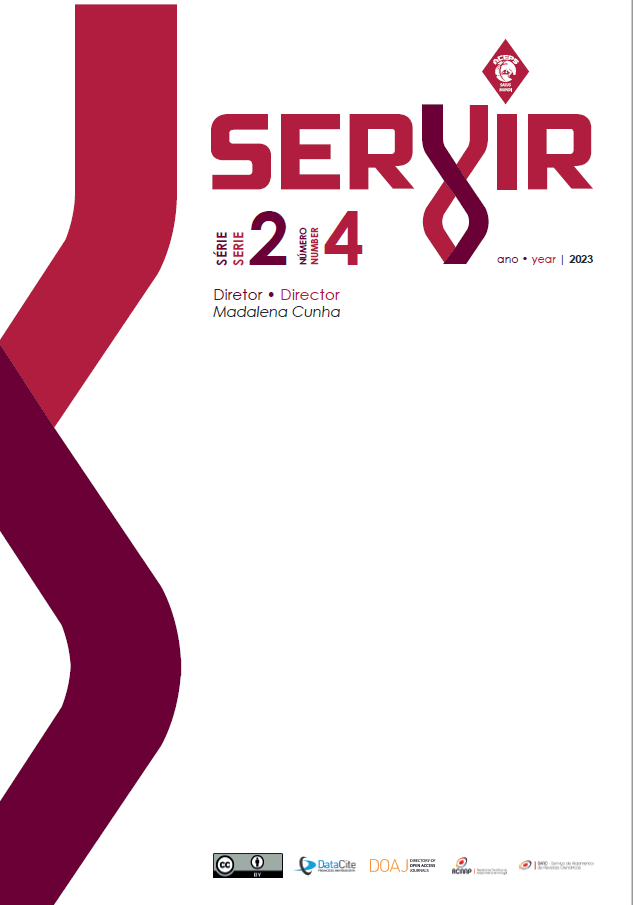Shock and mortality rate in victims of interpersonal violence assisted in the emergency department
DOI:
https://doi.org/10.48492/servir0204.28429Keywords:
interpersonal violence, shock index, mortality rate, urgencyAbstract
Introduction: Knowing the shock and mortality rate of these victims of interpersonal violence allows adjusted interventions in order to increase their survival.
Objectives: To determine the rate of shock and mortality in victims of interpersonal violence assisted in the emergency department.
Methods: Observational study, with a cross-sectional cohort and retrospective focus, in a sample of 221 victims of interpersonal violence, admitted to the emergency department of a hospital in the central region of Portugal. The Schok Index (Mutschler, et al., 2013) and MGAP (Sartorius et al., 2010) scales were applied. The study received a favorable opinion from the Ethics Committee for Health of the institution.
Results: Male predominance (63.0%) with a mean age of 45.6 years, with a higher record of admissions on Sunday (18.5%), in the afternoon (54.0%), with urgent priority (67.5%) and discriminator “pain moderate” (50.0%), with a higher record of physical violence (99.5%). Mild shock (60.7%) and low mortality rate (95.4%) were the most representative.
Conclusion: The application of the Schok Index and MGAP scales allows establishing differentiated interventions according to the victim's hemodynamic changes, reducing the risk of mortality. Giving special attention to victims of violence in the community and younger.
Downloads
References
Althunayyan S. M. (2019). Shock Index as a Predictor of Post-Intubation Hypotension and Cardiac Arrest; A Review of the Current Evidence. Bulletin of emergency and trauma, 7(1), 21–27. https://doi.org/10.29252/beat-070103.
APAV. (2022). Estatísticas APAV. Relatório anual 2021. Acedido por Relatorio_Anual_2021.pdf (apav.pt)
Bossoni, Alexandre. (maio, 2021). O que é trauma, quais os tipos e como tratá-lo?. Acedido por https://www.santapaula.com.br/blog/o-que-e-trauma-quais-os-tipos-e-como-trata-lo/
Cherry, J. D., Bermeo, J. M., Montoya, K. F., Calle-Toro, J. S., Núñez, L. R., & Poveda, G. (2015). Índice de shock como factor predictor de mortalidad en el paciente con trauma penetrante de tórax. Revista Colombiana de Cirugía, 30(1), 24-28.
Direção-Geral da Saúde (DGS). (2016). Violência Interpessoal - Abordagem, Diagnóstico e Intervenção nos Serviços de Saúde. 2ª ed. Acedito por https://www.dgs.pt/accao-de-saude-para-criancas-e-jovens-em-risco/ficheiros-externos/violencia_interpessoal-pdf.aspx
Grego, R. & Douglas, W. (2019). Medicina Legal – À Luz do Direito e do Direito Processual Penal. 12ª ed. Impetus. Acedito por Medicina Legal - Rogério Greco - Impetus Costa, F. A. D. D. (2021). Triagem de manchester: intervenção dos Enfermeiros. (Master's thesis).
Instituto Nacional de Estatística (INE). (2021). Conceito de Idoso. Acedido por Sistema Integrado de Metainformação - conceitos (ine.pt)
Koch, E., Lovett, S., Nghiem, T., Riggs, R. A., & Rech, M. A. (2019). Shock index in the emergency department: utility and limitations. Open access emergency medicine : OAEM, 11, 179–199. https://doi.org/10.2147/OAEM.S178358
Loutroukis, T., Loutrouki, E., Klukowska-Rötzler, J., Koba, S., Schlittler, F., Schaller, B., Exadaktylos, A. K., Doulberis, M., Srivastava, D. S., Papoutsi, S., & Burkhard, J. (2020). Violence as the Most Frequent Cause of Oral and Maxillofacial Injuries among the Patients from Low- and Middle-Income Countries-A Retrospective Study at a Level I Trauma University Emergency Department in Switzerland. International journal of environmental research and public health, 17(13), 4906. https://doi.org/10.3390/ijerph17134906
Milton, M., Engelbrecht, A., & Geyser, M. (2021). Predicting mortality in trauma patients-A retrospective comparison of the performance of six scoring systems applied to polytrauma patients from the emergency centre of a South African central hospital. African Journal of Emergency Medicine, 11(4), 453-458.
Mota, M., Cunha, M., Santos, E., Figueiredo, Â., Silva, M., Campos, R., & Santos, M. R. (2021). Eficácia da intervenção da enfermagem pré-hospitalar na estabilização das vítimas de trauma. Revista de Enfermagem
Mutschler, M., Nienaber, U., Münzberg, M., Wölfl, C., Schoechl, H., Paffrath, T., Bouillon, B., & Maegele, M. (2013). The Shock Index revisited–a fast guide to transfusion requirement? A retrospective analysis on 21,853 patients derived from the TraumaRegister DGU®. Critical Care, 17(4), R172. https://doi.org/10.1186/ cc12851
Organização Mundial de Saúde. (2014). Relatorio Mundial Sobre Prevenção da Violencia. Obtido de https://nev.prp.usp.br/wp-content/uploads/2015/11/1579-VIP-Main-report-Pt-Br-26-10-2015.pdf
Peixoto, G. S., Inácio, Q. L., & Gadelha, L. M. U. (2019). Ansiedade e depressão em pacientes internados vítimas de acidentes e violência física interpessoal. CEP, 62010, 660.
Pereira de Sousa, M. E., Rodrigues de Santana, M., Monte da Cunha, G. I., da Silva Sousa, M. R., do Nascimento Silva, I. M., & Ramos Gonçalves, F. (2020). Traumas em mulheres vítimas de violência: uma análise em Recife-PE. Nursing (São Paulo), 23(269), 4703–4710. https://doi.org/10.36489/nursing.2020v23i269p4703-4710
Queiroz, D.R., Barros, M. V. G., Aguiar, J. A., Soares, F. C., Tassitano, R. M., Bezerra, J., & Silva, L. M. P. (2021). Consumo de álcool e drogas ilícitas e envolvimento de adolescentes em violência física em Pernambuco, Brasil. Cadernos de Saúde Pública, 37(4), 1-10.
Rahmani, F., Ebrahimi Bakhtavar, H., Shams Vahdati, S., Hosseini, M., & Mehdizadeh Esfanjani, R. (2017). Evaluation of MGAP and GAP trauma scores to predict prognosis of multiple-trauma patients. Trauma Monthly, 22(3).
Sartorius, D., Le Manach, Y., David, J. S., Rancurel, E., Smail, N., Thicoïpé, M., Wiel, E., Ricard-Hibon, A., Berthier, F., Gueugniaud, P. Y., & Riou, B. (2010). Mechanism, glasgow coma scale, age, and arterial pressure (MGAP): a new simple prehospital triage score to predict mortality in trauma patients. Critical care medicine, 38(3), 831–837. https://doi.org/10.1097/CCM.0b013e3181cc4a67
Sheikh, S. (2020). Characteristics of interpersonal violence in adult victims at the Adult Emergency Trauma Centre (AETC) of Queen Elizabeth Central Hospital. Malawi medical journal, 32(1), 24-30.
Silva, J. A. V., Padula, M. P. C., & Waters, C. (2021). Perfil epidemiológico, clínico e desfecho de pacientes com traumatismo cranioencefálico/Epidemiological, clinical profile and outcome of patients with traumatic brain injury. Arquivos Médicos dos Hospitais e da Faculdade de Ciências Médicas da Santa Casa de São Paulo, 66(1u), 1-7. Acedido por https://doi.org/10.26432/1809-3019.2021.66.017
Published
How to Cite
Issue
Section
License
Copyright (c) 2023 Servir

This work is licensed under a Creative Commons Attribution 4.0 International License.
In order to promote the free circulation of knowledge, Servir is open access journal. All its content is available and protected under the Creative Commons license (CC BY 4.0).
The journal allows self-archiving in institutional repositories of all versions, which may become immediately available


